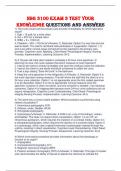Exam (elaborations)
Exam (elaborations) SAEM
- Course
- Institution
The answer is A. A fluctuant, indurated area such as that pictured and described, tends to not respond to antibiotics (which cannot penetrate well into the abscess cavity). Cruciate incisions are unnecessary and risk wound healing problems. A 30 gauge needle is too small, and needle drainage o...
[Show more]












